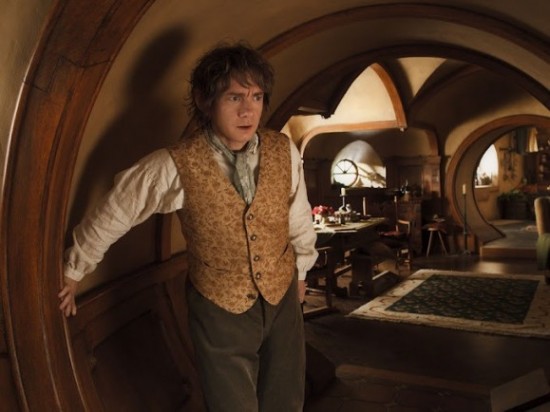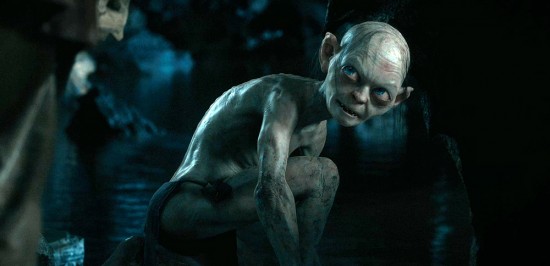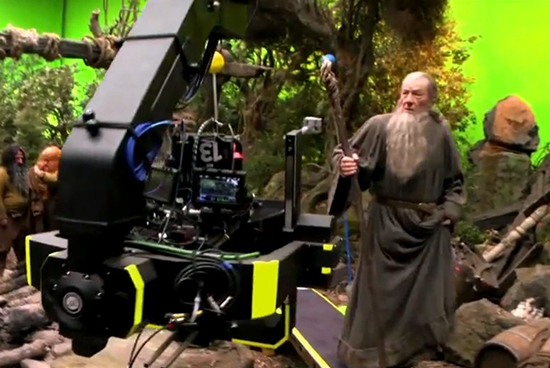High Frame Rate And 'The Hobbit:' The Allure Of Middle-Earth Is Crystal Clear At 48fps
In the first frames of The Hobbit: An Unexpected Journey, the camera briefly lingers on a pair of hands in close-up as they light a candle. As the small flame flares, the camera pulls back to show the aged Bilbo Baggins (Ian Holm), and the seemingly mundane sequence concludes with a shot that might be unlike anything else you've ever seen in a theater.
Peter Jackson shot The Hobbit on digital cameras that captured images at 48 frames per second. That 48fps speed, which we'll refer to as High Frame Rate (HFR) from here out, is twice the long-held industry standard 24fps. The benefits of HFR include reduced or eliminated motion blur, and a notable increase in general clarity. The downside is that HFR doesn't look exactly like cinema, or at least not like anything typically projected on film screens.
With those downsides noted, consider this, too: that first shot of Ian Holm as Bilbo has more visual information than any shot of the actor in any other film. He appears to be in the same room with the audience. Details of Holm's hair (a wig), his prosthetic ears and well-designed wardrobe are impossible to miss. It feels, at first, as if it's impossible to miss anything, so clear is the picture.
Weird, that such heightened clarity should anger so many cinephiles.

The naysayer's claim is that HFR makes The Hobbit look like a BBC miniseries, or even a soap opera. That leads to a claim of the film looking cheap, which is absurd. Anyone who knows even a bit about film production can see, with astounding clarity, that The Hobbit is not cheap. The costumes and sets are impeccable. Jackson doesn't seem to rely on sets quite as heavily as he did in the Lord of the Rings films — Rivendell, for example, appears to be primarily a digital creation — but constructions such as Bilbo's home at Bag-End are spectacular. Bag-End looks like a place I could move into tomorrow. Exterior locations are captured with the sort of immaculate detail rarely seen outside IMAX-format documentaries.
I will allow that there is a visual kinship to quickly-produced TV drama. It crops up particularly in bright daylit scenes, where Jackson and cinematographer Andrew Lesnie, who also photographed the Lord of the Rings films, favor flat lighting. The lighting is important. Soap operas are lit in a broad manner that allows many setups to be captured on a set in the shortest possible time. The scenes where my mind clicked to "soap opera" all featured similar, flat lighting.
In those scenes, Jackson's trademark visceral camera have been set aside in favor of a different approach to cinematography and blocking. Actors are arranged in theatrical fashion, and the movement comes from within the frame, more than from the camera operator. That choice might be a facilitation of 3D, which favors such mise-en-scene. But those elements of lighting and camera movement aren't Jackson's typical style, and they don't look like Lord of the Rings. HFR is taking the blame for the difference.

And yet, when Jackson does fall back towards a visual style that is more recognizably his own, HFR makes the image pop in dramatic fashion. When the film's company of Dwarves runs afoul of a massive warren full of goblins midway through the film, the underground vistas are clear down to the last tiny rope walkway. In the swirling mass of goblins, I can make out distinguishing marks, down to the last boil. When the camera pushes in on unforgiving close-ups of the Goblin King, I lean forward in wonder. The detail in his face is almost an assault, it's so dense.
Consider the challenge of using a technology such as HFR in a setting where there are so many possible shortcuts to reveal. Every character in the film features heavy makeup or prosthetics. Many wear outlandish beards; all are draped in wardrobe manufactured from whole cloth, leather and metal. They wield weapons that can't look real, because they often aren't. Every part of every frame is full of raw-built materials, but I don't see something that looks "fake." I see a deep display of craft, of which and prop and costume departments would be jealous.
And consider the brass balls Jackson must possess, to point our eye to an all-digital creation like the Goblin King or Gollum. Then factor in that the eventual projection will be on giant IMAX screens, with clarity rivaled only by the much-vaunted IMAX film system. Jackson doesn't merely ask us to look: he invites us to linger. I've seen The Hobbit twice, both times in HFR, and each time I was eager to linger, because those sights are amazing. There are moments in The Hobbit that don't look like anything else I've seen projected on a screen.
Does The Hobbit look real? Not at all. It's fantasy; it can't possibly look real. But it often looks spectacular.

Digital cameras have already leveled the playing field in filmmaking as a whole. There is no longer any technological barrier to entry for anyone who wants to tell stories with moving images. HFR could become a similar democratization for production of the sort of high-detail filmmaking that has been the exclusive provence of large-frame formats such as IMAX. Shooting in IMAX requires expensive, bulky, difficult rigs. HFR requires skill, but a relatively inexpensive RED camera can capture at 48fps.
(There's a related argument to be had about the cost of upgrading projectors to display HFR. But digital projectors such as Sony's Digital Cinema 4K line can be prepped for HFR with a $3000 software update. That's not cheap, but it's far less than the cost of upgrading to digital or 3D. I'll let someone more versed in the economics of exhibition tackle that argument.)
I don't mean to suggest that using HFR will be the same as shooting in native IMAX. There's a subtlety to IMAX that HFR does not yet exhibit. (This is the first HFR film! Give it a minute, please.) But the high frame rate approach is now an option on the table. It's a tool like any other, to be used well, or poorly. For a creative team with the confidence to stare down HFR's ability to expose flaws in sets and makeup, it could deliver great rewards. If Steven Soderbergh had shot Haywire at 48fps, for example, I wonder if the conversation would be dominated by the fact that the film's fight scenes were unlike any we'd seen before. Instead, because the tech debuts with a film that bears the weight of massive audience expectations, HFR is being cast as one of the horsemen of cinema's apocalypse.
I can't understand anyone with a real interest in cinema avoiding The Hobbit in HFR. It has to be seen; 48fps is a new way of looking at Middle-Earth, and at movies. There's a place for this technology. OK, for a horror film, maybe not. (I would, however, love to see some filmmaker nail it.) But I imagine a film like Lincoln, shadowy as it is, shot in HFR, and wonder what it would be like to see Daniel Day-Lewis's eyes gleam in a new light. That, too, might be spectacular.
